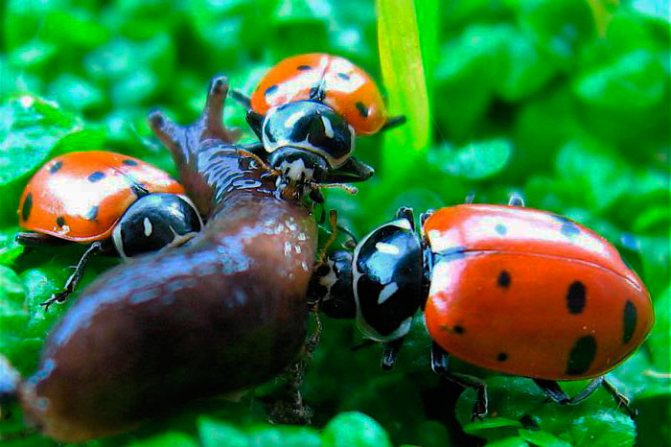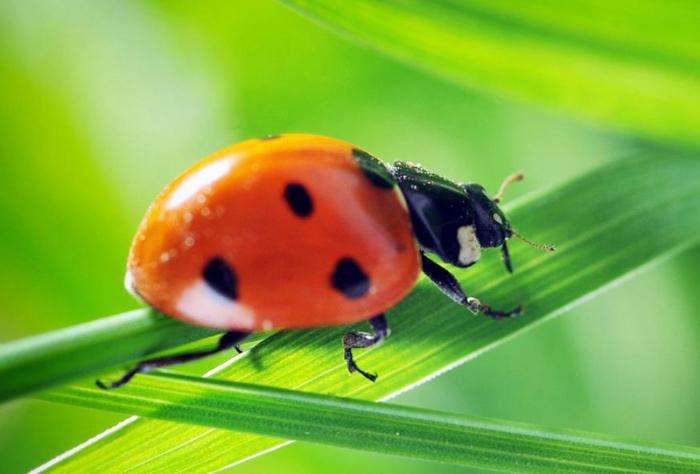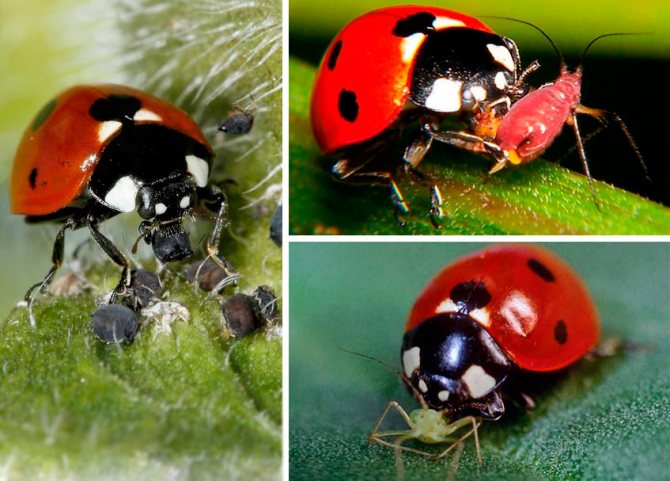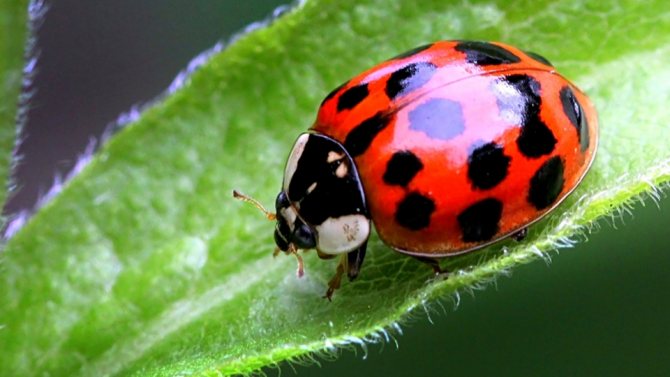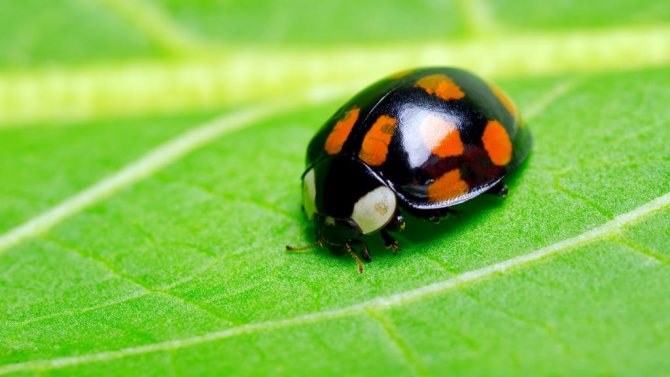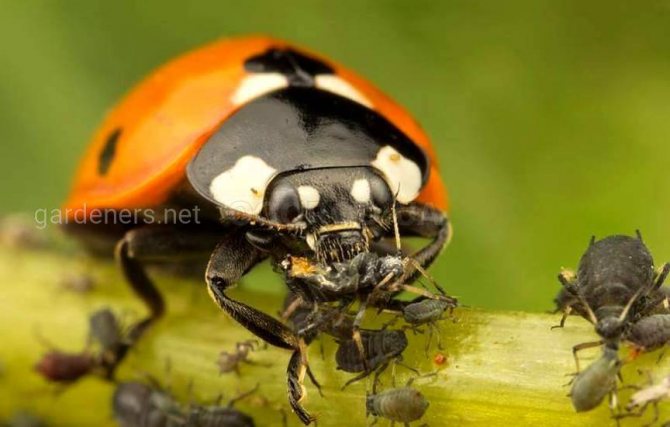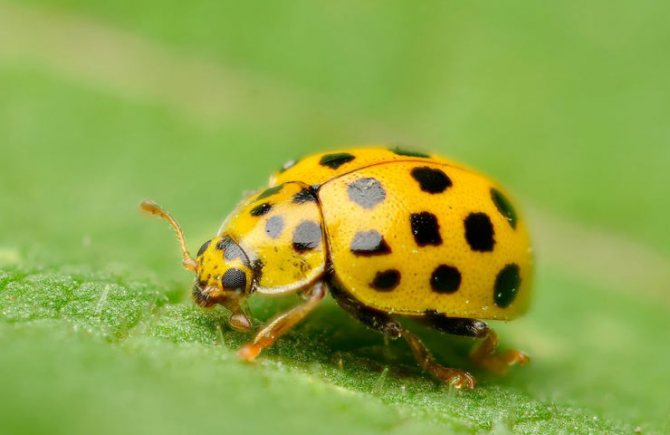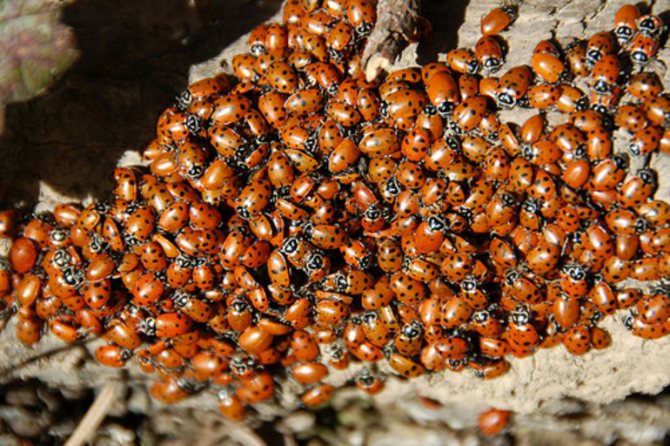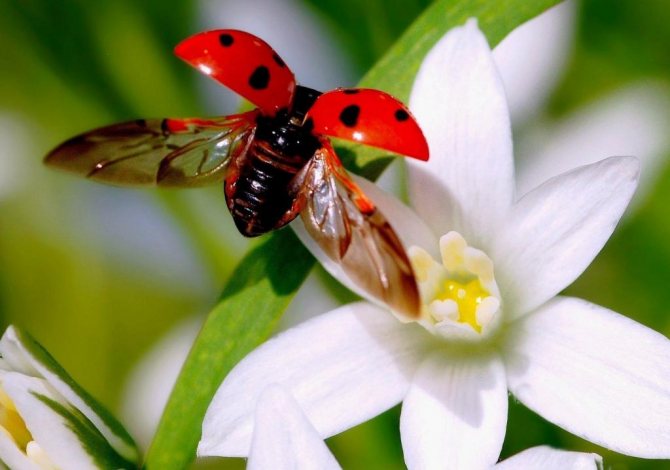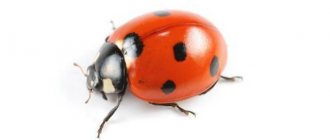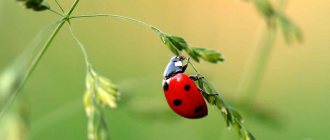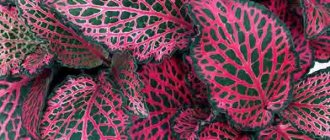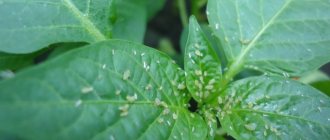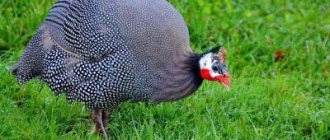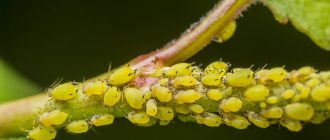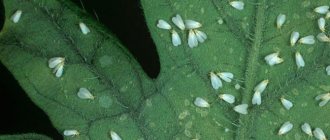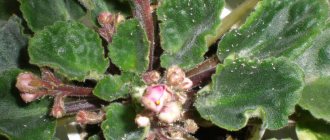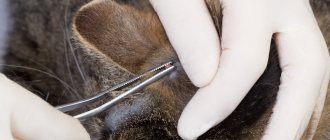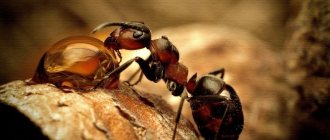What do ladybugs eat and what do they eat at home?
What do ladybugs eat? Most of them are predators and eat other insects, many of which are considered serious plant pests. The ladybug is often referred to as the gardener's best friend. They eat aphids, thus controlling the number of pests in the garden and replacing the use of chemical pesticides. The larvae of the ladybug also feed on aphids. They also eat other insects that have soft bodies - ticks, whiteflies, scale insects, and others.
It is surprising for some to learn that the ladybug is a predator. They eat insects and their larvae, most of which are pests. The most favorite food of ladybugs is aphids and their larvae. One ladybug in a year and a half can eat more than 6,000 aphids. So these colored bugs unconsciously save agricultural lands from harmful parasites.
In addition to aphids, the ladybug eats small pest caterpillars, slugs, eggs of butterflies and the Colorado potato beetle, scale insects and spider mites.
In winter, ladybugs do not eat anything, as they go into hibernation or a state of suspended animation. Before winter, ladybugs accumulate glycerin and sugar in their tissues, as well as remove a large amount of water from the body, so that when cold weather sets in and the body cools down, it does not burst from the temperature drop.
With the onset of cool days, insects begin to look for warm places for wintering. Ladybugs can concentrate in one place in large numbers for the winter. Before wintering, insects fly in flocks over the city in search of a new refuge. Most often, ladybugs remain for the winter in heaps of dry leaves, in the bark, under stones, in forests, in the crevices of windows, sometimes organizing huge clusters.
Ladybugs are very useful: they themselves and their larvae feed on pests - aphids. So if the ladybugs decide to overwinter in your garden, you can be sure that in the summer you will be protected from aphids in the garden. But do not rush to completely plow the area, otherwise you will lose your defenders from aphids for a long time.
The ladybug has wings and is a flying insect, among them there are breeds called "migratory". They are like birds, they can fly away to winter away from their place of feeding. But naturally, there they hibernate, only in huge groups, sometimes even several tons in weight.
How many species of ladybug were not listed, almost all of them are predatory insects. As a rule, they prefer to eat harmful aphids and mites, which are located on the leaves of plants. In addition, bugs and other insects are not averse to feasting on. Caterpillars, a variety of eggs and larvae are the norm in the ladybug's diet.
But there are also vegetarians among them who prefer exclusively plant foods. Such insects prefer to collect pollen from inflorescences, flowers themselves, leaves. Remarkably, even mushroom mycelium is used.
Name
The positive attitude of people towards the ladybug is reflected in the name given to the insect. The epithet "god" in its name is present in many countries. Catholics call the insect a ladybird or ladubug. At the same time, lady means in this case the Virgin Mary. That is, the ladybug is, in their understanding, an insect of the Mother of God.
According to popular beliefs, a ladybug descends from heaven and brings goodness with it. This insect has always been treated as a holy creature, which was considered a sin to kill.
Ladybug: life cycle
There are more than 4000 species of these interesting representatives of the insect world in the world (Latin name: Coccinellidea). What do ladybugs eat? Adults and larvae feed on soft-bodied pests, plant mites and egg pests. They love aphids the most! One individual usually eats more than 5,000 aphids in its life.
The larvae go through several stages of maturation. After about a month, the larvae pupate, a week after that, young beetles appear. At this stage, they are completely different from the adults that people are used to calling ladybirds. Distinctive features are specks and bright color, which are needed in order to make them less attractive to any predator.
During the spring and summer months, the ladybug eats up, accumulates reserves for wintering. As soon as the chill sets in, these beetles begin to hibernate, and in the spring a new round of life starts, and those ladybugs that were able to overwinter begin to lay larvae, but these individuals already die by the full life of the new generation.
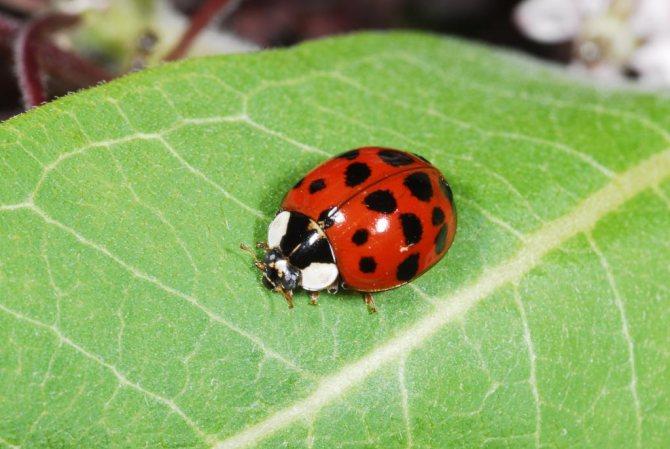
In scientific books they are called "Coccinellidae", or "Coccinellid", in other countries the ladybug is called differently: "the beetle of the Holy Virgin Mary", "the beetle of St. Anthony", "Sun". In Tajikistan they are called "Red-bearded grandfather". This name shows how reverently summer residents are about a beneficial insect.
Description
Perhaps this is the most famous representative of beetles for both adults and children. There are few people who would not know what a ladybug looks like.
This insect has a rounded body. It is convex at the top and flat at the bottom. The most common in nature are red and yellow ladybugs with black spots on the back. But these are not all types. There are about four thousand of them in total. The ladybug also comes in black, blue, light blue and other colors.
Instead of dots on the back, she can have stripes and even patterns that resemble letters.
A bright color is necessary for a ladybug to protect against predators. If this insect falls into the spider's web, it has a chance of salvation, since the enemy himself tries to get rid of such a captive, breaking his own trap.
The ladybug has a pair of wings with which it can fly. They are protected by a pair of upper wing elytra.
There is a pair of black antennae on the head. The ladybug has three pairs of long legs. A liquid with an odor is released from their folds when the insect senses danger. The ladybug has the ability to pretend to be dead if something threatens her. She falls on her back and curls her paws.
The insect belongs to the family of beetles. It has a hemispherical (occasionally ovoid), convex body, a short head, surrounded by ten or eleven miniature ties, which the insect can bend under its head. The abdomen is composed of six free segments. The body of the insect is small and rarely exceeds 12 mm in length. The average size is usually about 5-6 mm.
We invite you to familiarize yourself with Life on Earth, the theory of the origin of life on Earth - the world of space
When pronouncing the name of an insect in the head, the image of a small bug with a red tough skin covered with small black dots is usually modeled. In fact, the back can still be yellow, black, blue or blue. In addition to the usual dots, there are also striped and even ornamented species. This kind of decoration can be not only black, but also white.
The beetle's wings consist of two pairs. The first consists of two small shells. They cover the main thin translucent wings of light or dark brown color.
On the head of the insect there are short black antennae. Three pairs of legs are attached to the body.
It is noteworthy that the insect is well protected from the attacks of other creatures. The color itself is already a good deterrent. In addition, when sensing danger, the bug releases a thick orange-yellow liquid with a pungent odor. There are situations when an insect can pretend to be dead.
These beetles from the order of beetles are found in almost all climatic zones of the world. There are nearly 4,000 species on the planet; only on the territory of our country 221 species of these insects live.
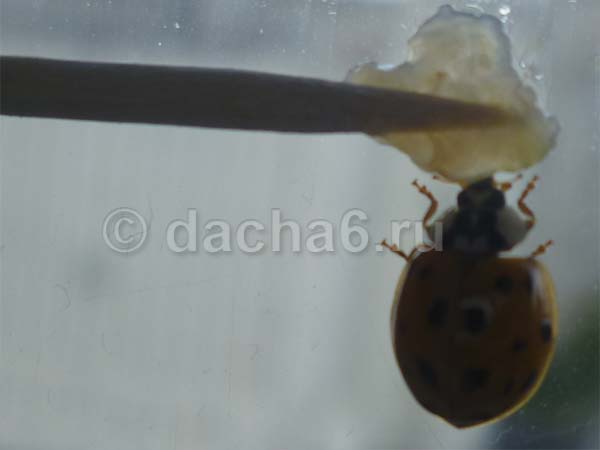

Ladybugs differ in size, body shape, elytral color and number of spots. So, shades can vary from yellow and orange to poisonous red. These vibrant colors protect insects from birds of prey and other insects.
The lifespan of a ladybug is 1 - 2 years. During this time, the insect goes through 4 stages:
- egg;
- larva;
- chrysalis;
- and the imago is an adult insect.
During the spring and summer, the ladybug eats off, accumulating reserves for wintering. With the onset of cold weather, it hibernates, and in the spring those individuals who were able to survive the winter lay 1 - 2 dozen eggs and die by the hatching of a new generation.
The scientific name of the ladybug sounds like "Coccinellidae", or "Coccinellid", but much more often this insect useful for the gardener is called differently: "beetle of the Holy Virgin Mary", "beetle of St. Anthony", "Sun". And in Tajikistan he is respectfully called "Red-bearded grandfather." These names best show how much gardeners value this bright bug.
Appearance and features
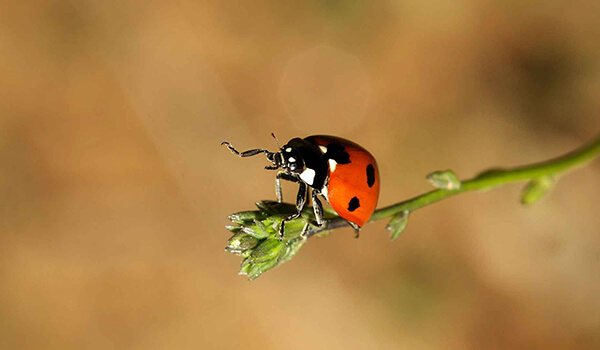

Photo: Ladybug in nature
The size of the ladybug ranges from 3.5 to 10 mm. The head of the bug is small and motionless. The eyes are relatively large, the antennae of 8-11 segments are very mobile and flexible. The body of a ladybug consists of a pronotum, a breast, three pairs of tenacious legs, an abdomen, and wings with elytra. The pronotum of the insect is convex, often with specks of various colors and shapes. The beetles fly using the rear pair of wings, while the front, in the process of evolution, was formed into strong elytra, which now serve as protection for the main pair of soft wings. Not all ladybugs have the usual scarlet color and black dots on the back.
Of all their diversity, the following varieties can be distinguished:
- two-point - a bug with a body size of up to 5 mm. It has a black pronotum, and two large black specks adorn the bright red elytra;
- seven-point - has a size of 7-8 mm, widespread throughout Europe. On its red back, two white spots and 7 black ones stand out;
- twelve-point - a red or pink beetle with an elongated body shape and 12 black spots;
- with thirteen dots - they are distinguished by an elongated body and a dark brown or red-brown color of the back, the spots can merge with each other;
- fourteen-point - a characteristic feature of the elytron, yellow or black;
- seventeen-point - the size of the insect is not more than 3.5 mm, it has a bright yellow back with black dots;
- blue - found only in Australia;
- ocellated - has a large body size up to 10 mm. All black dots on the red or yellow back of the insect are framed by light rims;
- dotless - their size does not exceed 4.5 mm, they have a dark brown color of the back, their body is covered with fine hairs. They are extremely rare in nature.
Not all species of ladybug are beneficial to humans. Alfalfa is a pest for many types of agricultural products. crops, it actively eats young shoots, destroys the harvest of beets, cucumbers, and so on. The bug is distinguished by a small size of up to 4 mm, it has a red back, strewn with 24 points.
Interesting facts about ladybugs
- In the wild, ladybirds can live for up to 3 years.
- The length of an adult reaches 1 cm.
- During the life cycle, the spots on the back of the ladybug gradually brighten.
- The ladybug breathes through the holes located on the sides of her body.
- In case of danger, ladybugs secrete a yellow liquid that is toxic to other insects. And if that doesn't work, the sly spotted bug may pretend to be dead and tasteless.
- For a summer resident, a ladybug is one of the most welcome guests and a hardworking assistant in the garden.
- Under suitable conditions, a ladybug may well live for some time in closed rooms, for example, in apartments. There she will lay up to 20 eggs and soon not only children, but also parents will be happy.
- The average life span in the wild is 2-3 years on average.
- The length of the insect, as a rule, reaches 7-10 millimeters.
- To clear its head and antennae, the ladybug uses its front legs.
- In the process of growing up, the spots on the flaps become lighter.
- The wing flaps are approximately 85 times per second.
- Breathing is carried out through holes on the sides of the body.
- A ladybug can hide its head in its torso under certain conditions.
- The larvae grow very quickly and change their appearance 3 times.
- In some countries, it is generally accepted that they bring good luck.
- When ladybugs feel threatened, they begin to secrete a special yellowish liquid that smells bad and is toxic to other insects. This is their kind of defense mechanism. In some cases, they can even pretend to be dead.
- They are welcome guests in any garden, as they feed on garden and garden pests.
- Ladybugs will also live indoors.
Although this bug is a predator, it can also be endangered. Who are the ladybirds? Some species of birds (including the sparrow) are especially dangerous for them. Certain species of flies also feed on ladybug larvae.
In most countries, this insect is respected and even idolized. Many people believe that this insect is a symbol of good luck, therefore, in no case can it be harmed. The ladybug was depicted on clothes, shoes, ornaments. This was considered a talisman. Numerous signs associated with this bug have survived to this day. So, the ladybug, which sat on the hand, cannot be chased away. It is believed that by doing this, a person repels fortune.
Interesting to know
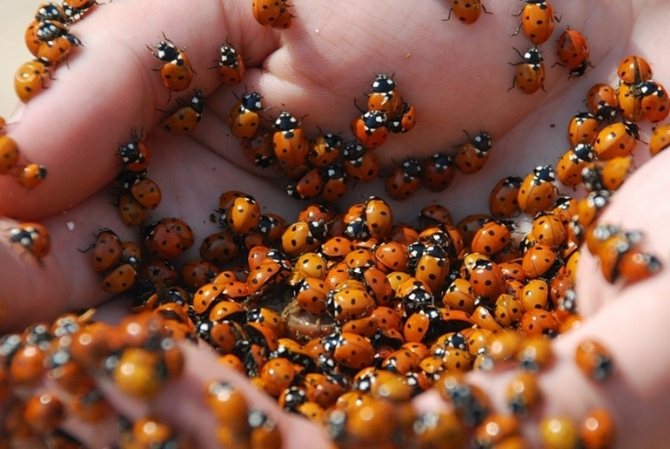

Folklorists believe that the name of the beetle is directly related to the ancient Slavic pagan goddess of agriculture and fertility Mokosh. The flight of an insect from a finger was accompanied by the well-known request for bread ("fly to heaven, bring me bread") as a symbol of productivity and prosperity. This explains her divinity.
Ladybugs are insects popular for their bright colors. The best habitat for ladybugs is wildlife, but if you happen to find an insect near your home and want to take care of it, it's not difficult to do so - provide the ladybug with food, water and recreate the natural conditions of its habitat.
Do you think I'm completely crazy?
Well, yes, you're right, she was found in deciduous litter, which I brought from the forest. More precisely, there is a ton of ladybugs) but I did not tell the children about this.
Do you love ladybugs? Cold weather set in, and you found a ladybug that has nothing to eat and drink, since all the water is frozen? Do you want to help her? You can take her as a pet! Ladybugs like aphids, which are garden pests found on plant leaves.
Part 1 of 3: Finding the Ladybug
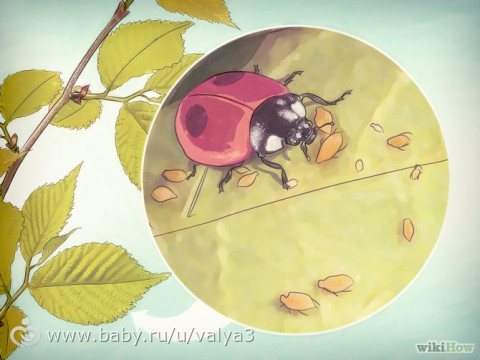

Find a ladybug.
Look where ladybugs usually hide: under the leaves of aphid-infested plants (look at roses and other flowers, or flowering fruit trees).Ladybugs also like to hide in crevices that can be found on buildings, such as window frames.
Ladybugs love aphids as their main food source.
Take the ladybug. Catch the ladybug with a butterfly net or with your hands, just don't let it fly away. Cover it with your other palm, but do not crush it.
Carefully put the ladybug in the jar, you can already start taking care of it
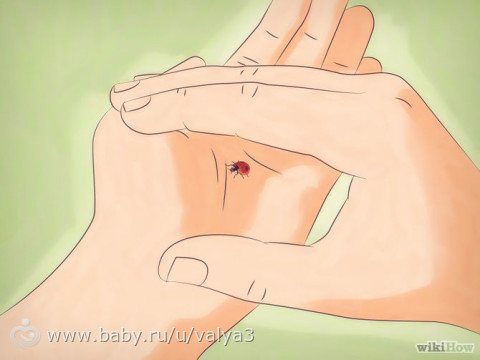

Part 2 of 3: Home improvement for the ladybug
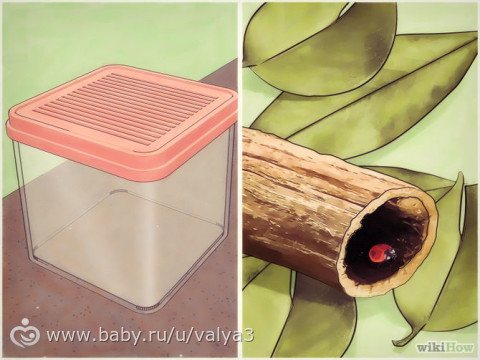

Use a large enough plastic container for the ladybug.
The size of the container should be large enough for small flights and for a night's sleep. Add twigs, leaves and petals to it for a change (any leaves and flowers must be changed daily to prevent rotting). Provide the ladybug with a place to hide, such as a hollow stick or a small toy with holes in it
- You can also use an insectarium.
- Glass jars are not recommended as they overheat quickly and can burn the ladybug, especially when placed in direct sunlight.
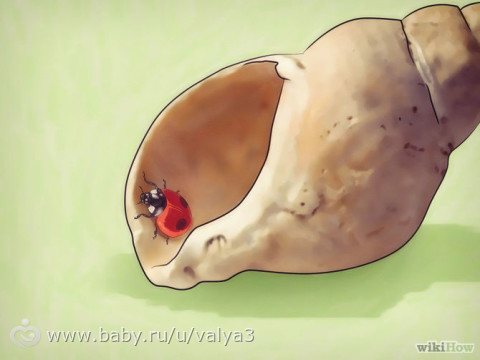

If keeping the ladybug for more than 24 hours, use a hermit crab container.
They will not be able to get out of it, but at the same time they will be comfortable. Add fresh herbs daily. You also need to feed the insect daily.
Part 3 of 3: Caring for your ladybug
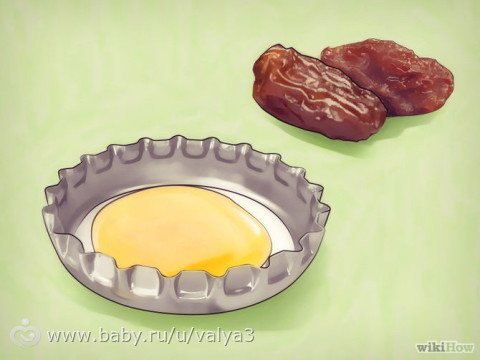

Provide food for the ladybug.
Feed her a little honey or sugar. Place food in a small bottle cap.
You can also feed the ladybug with raisins or lettuce.
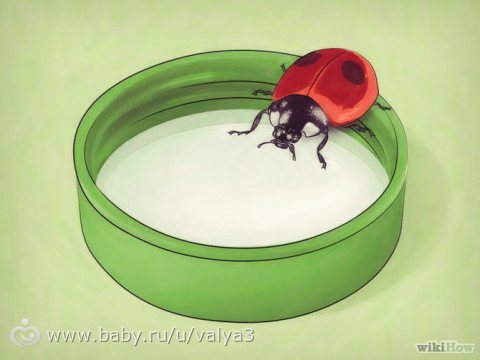

Pour into a plastic bottle cap with water.
There should be very little water so that the ladybug does not drown.
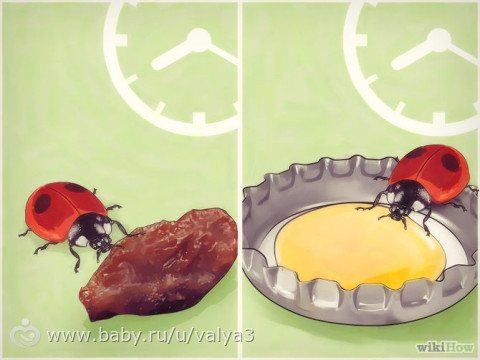

Feed the ladybug twice a day.
You shouldn't give her too much food, just a little bit is needed.
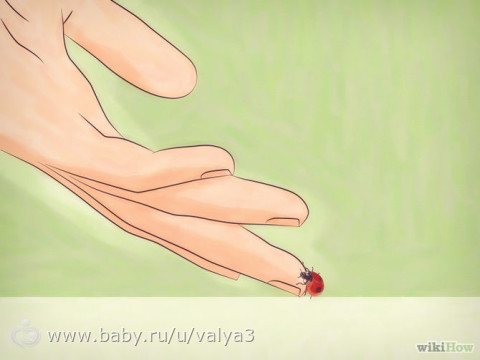

Be careful when handling the ladybug.
This must be done as follows:
- Place your finger next to the ladybug. He should touch the surface on which she sits.
- Wait for the ladybug to crawl or fly onto your finger.
- Now you have it on your hand, but be careful!
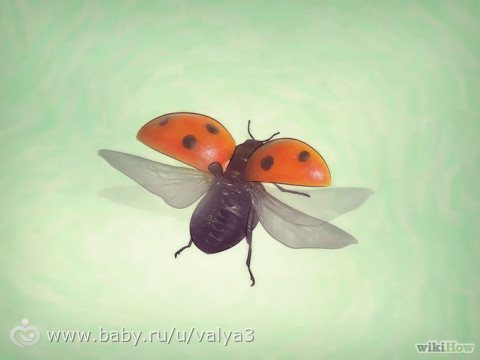

Consider releasing the ladybug in 24 hours.
You've had enough time to become familiar with her habits, return her to her usual duties of saving your garden from pests.
Well ... We considered the possibility of letting go, but came to the conclusion that NO)))))))
Therefore, she now lives like this)
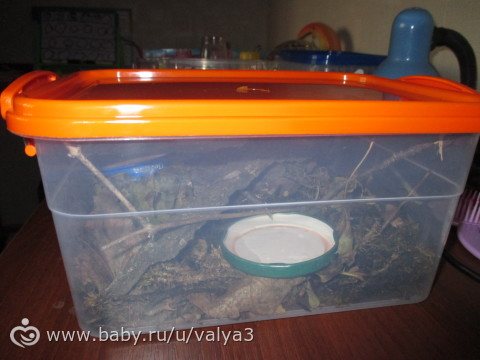

Today, honey is in her diet. she was hungry ... hmm ... how long she still sat in the sack ... a half a month. Therefore, she immediately rushed to eat)
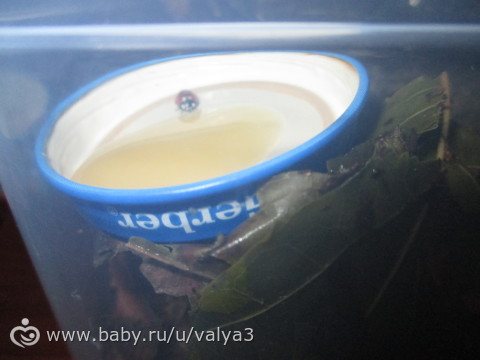

^ _ ^ mimimi, if I still find a ladybug in litter, I will throw it over to this one, so it’s not boring)))))))))))
Ladybug nutrition
The ladybug can be found anywhere in the world except Antarctica and permafrost zones. This insect prefers to settle in trees, meadow grass or on plants growing near water bodies.
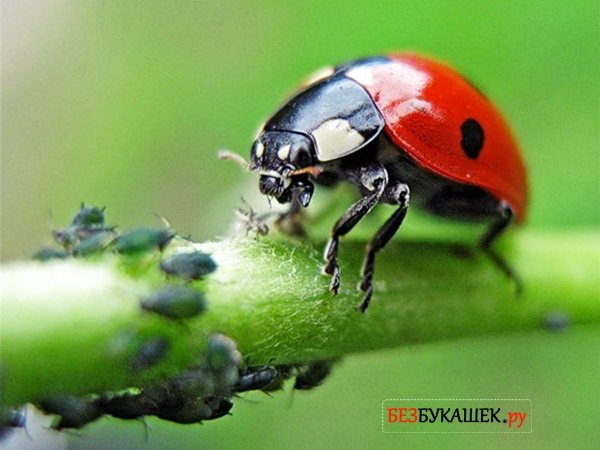

Like migratory birds, ladybugs gather in flocks in spring and autumn and fly long distances. This is for the purpose of finding food. During the flight, the bugs fly quite high. They cannot be seen with the naked eye. A strong wind can prevent them from doing this. Because of its gusts, insects are forced to interrupt their flight, and if they are above the sea, this often leads to their death.
Many ladybugs hibernate in the forest, hiding under leaves or under the bark of stumps until spring.
In spring or autumn, ladybugs lay yellow eggs on plant leaves. Their number varies from five to three hundred pieces. The larvae appear in a week. They have well developed jaws. Larvae eat more food than adults. They are dark green in color, masking them against the background of leaves.
Two weeks later, a pupa is formed from the larva, and after the same period of time a young ladybug beetle appears. In the beginning, it lacks patterns on the wings, and the color is still too pale. Over time, the beetle acquires a rich color and pattern. The entire development process from egg to mature individual takes four to seven weeks.
After completing her mission, the ladybug dies. The insect's life cycle lasts just over a year. The new generation of ladybirds will soon prepare for wintering, after which they will hatch their offspring and then also die.
Looking at this cute insect, many are wondering what ladybugs eat. We will understand this further.
These cute-looking bugs are actually predators. Thus, they are very useful for gardeners. Why? This question can be easily answered by learning more about what ladybugs eat. Garden pests form the basis of their diet.
We suggest that you familiarize yourself with Axolotl: a description of how long it lives and where it lives
Ladybugs help preserve cultivated plants by eating harmful insects. They especially love to feast on aphids, which, as you know, destroys all plantings. For the development of one ladybug larva, about a thousand of such insects are needed. An adult beetle consumes about two hundred aphids per day. This is a huge help to people in saving the harvest from destruction. Other beetles that do not have a shell are also eaten.
Many people have a question: what do ladybugs eat besides animal food? Sometimes there are species of this insect that are vegetarians and feed on plants, namely mushrooms and leaves. Almost all of them live in Latin America and southern East Asia.
In our country, there are only three types of such ladybugs: pointless coccinellid, alfalfa beetles, twenty-eight-point ladybugs. They are common in the central, southern parts of Russia and the Far East, respectively. These species can harm garden plants.
The larvae feed in a similar way. They differ from adults only in the amount of food they eat. We now know what ladybugs eat in nature.
- March 25, 2019
- Travel tips
- Elena Nikitina
The ladybug is an arthropod insect familiar to many from childhood. This bug is very fond of kids. It evokes tenderness, unlike cockroaches and other brethren. Meanwhile, few people know how long the ladybug lives, what it eats and where this original name of the insect came from.
What does a ladybug eat in nature? It all depends on where the insect is located. These bugs feel great almost anywhere in the world. They are not only in Antarctica. Ladybirds can be found in large numbers in America, various regions of Europe and Asia. Such insects live in all countries of the former Soviet Union. They also exist on the territory of Russia.
Most often, insects choose plants for life on which a colony of aphids settles. Some species prefer to settle on reeds near water bodies or in field grasses. Almost all insects lead an isolated lifestyle. They do not like to depend on relatives. Insects gather together only during the mating season. All types of ladybugs are thermophilic. Before the onset of winter cold, insects gather in huge flocks and fly away for the winter.
Some subspecies remain to winter in Russia. Ladybugs gather in huge communities, they choose stones and tree bark as a shelter. However, insects do not live long. Under favorable conditions for them, life expectancy does not exceed a year. Most often, the insect lives for only a few months.
Despite its pleasant appearance, the bug is a predator in the world of insects.Almost all species of this bug eat ticks and aphids, they can also eat butterfly eggs, small caterpillars are a real delicacy. If there is no alternative food, ladybugs do not disdain the eggs of the Colorado potato beetle.
There are also subspecies of this insect that feed exclusively on plant foods. The diet of bugs includes leaves, inflorescences and plant pollen. Some insects can eat even small fruits.
The breeding season of the ladybug falls on the relatively warm season. Typically, this is mid-spring or early fall. The female is capable of laying from 5 to 250 oblong yellow eggs at a time. He chooses the place carefully. As a rule, there are many aphids. After a week, the larvae appear.
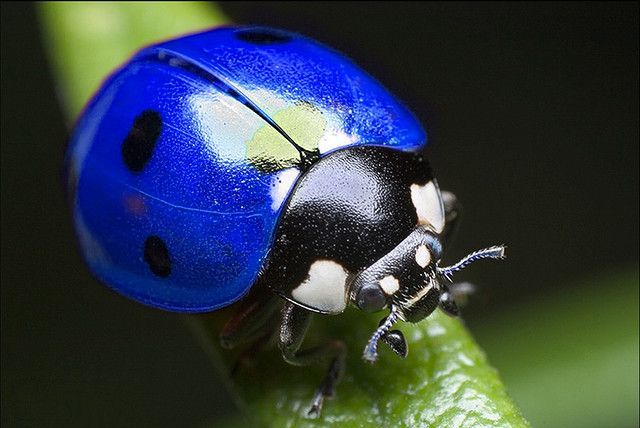

The jaws of a young individual are not worse developed than those of an adult. For plants, larvae are more beneficial, eating significantly more harmful insects. A hungry individual is able to overcome a rather large distance by their standards, up to 12 m.
The period of growing up of a ladybug passes quickly enough. After 15 days, having reached maturity, the larva becomes a pupa, from which the ladybug then appears. The entire cycle takes 4 to 7 weeks, and the lifespan is about a year. With a shortage of food, this period is significantly reduced, amounting to several months.
Reproduction
In spring or autumn, ladybugs lay yellow eggs on plant leaves. Their number varies from five to three hundred pieces. The larvae appear in a week. They have well developed jaws. Larvae eat more food than adults. They are dark green in color, masking them against the background of leaves.
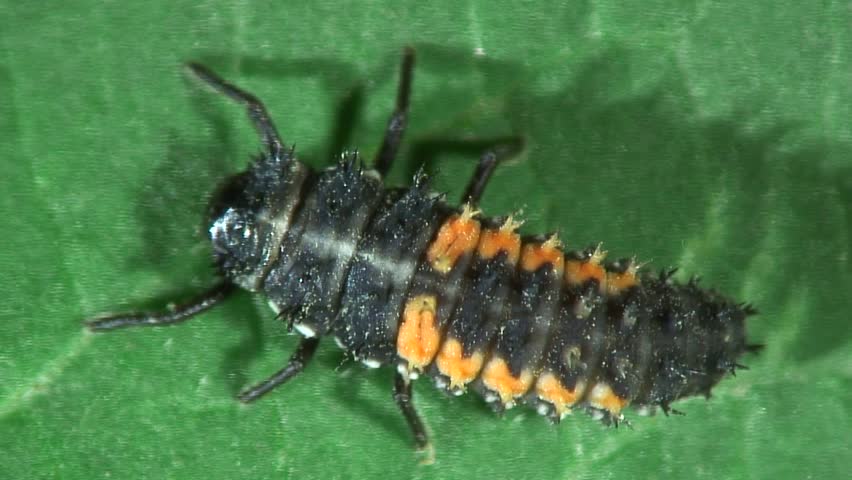

Two weeks later, a pupa is formed from the larva, and after the same period of time a young ladybug beetle appears. In the beginning, it lacks patterns on the wings, and the color is still too pale. Over time, the beetle acquires a rich color and pattern. The entire development process from egg to mature individual takes four to seven weeks.
After completing her mission, the ladybug dies. The insect's life cycle lasts just over a year. The new generation of ladybirds will soon prepare for wintering, after which they will hatch their offspring and then also die.
Looking at this cute insect, many are wondering what ladybugs eat. We will understand this further.
What does a ladybug look like?
Some representatives have red elytra with black dots, in nature there are also orange, black with red dots, completely brown or black. The structure of the body includes the head, chest, and abdomen. There are a pair of antennae, a pair of faceted eyes on the head, and six segmented legs that attach to the ribcage.
There is an additional pair of thin wings under the thick, rigid elytra. Different species have different eating habits. What do ladybugs eat? In nature, there are predatory and herbivorous species. Vegetarians in the ladybug family feed on mushrooms and leaves. Some people eat insects that eat plants (aphids, midges).
Origin of the species and description
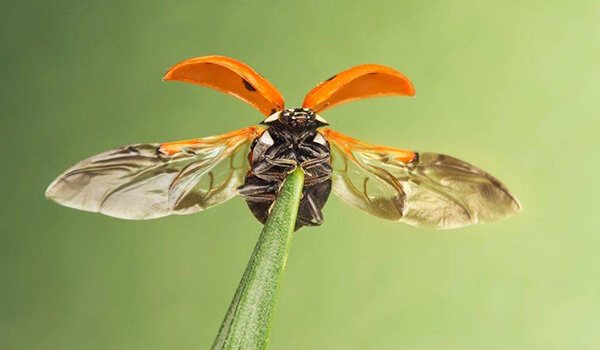

Photo: Ladybug
The ladybug is a very common ancient arthropod insect all over the world, a representative of the order of beetles and the family of ladybugs. This insect got its scientific name Coccinellidae due to its scarlet color. The bug lives almost everywhere. The people called him a cow because of the poisonous liquid of white color or "milk", which the insect secretes to scare away predators, and God, because he helped in the fight against aphids and other pests to preserve the harvest, had a meek disposition, did not cause any harm to humans ...
Video: Ladybug
In Germany, Switzerland, the tiny insect is called St. Mary's bug, in South America - the ladybug of St. Anthony.There were many legends about this little bug, he was prescribed the ability to influence the weather.
Interesting fact: the Slavs in ancient times considered the ladybug to be a heavenly creature, the messenger of the sun. That is why it was also often called "The Sun". The insect was forbidden to drive away so as not to incur failure. A bright bug that flew into the dwelling brought grace.
There are a huge number of species of ladybirds: the whole family has more than four thousand species, which in turn are divided into 7 subfamilies and 360 genera. The ladybug differs from other representatives of the Coccinellidae family in the structure of its legs. In the structure of each of them, there are three visible and one hidden segment, so they seem to be three-part.
Protectors of crops and ornamental gardens
The ladybug is a member of a family that includes thousands of insect species. When people hear the words "ladybug," they imagine bright red beetles with black spots, although these beneficial insects come in a variety of colors, with or without spots. What do ladybugs eat? They live in gardens around the world and are often welcome guests as they eat pests and other small insects.
Males and females of many species are very similar, they can only be distinguished by biologists. What do ladybugs eat? As a rule, after spring mating, they produce large clutches of eggs, which are located next to a colony of aphids and other small insects. When the larvae hatch, they can feed on insects until they are large enough to fly and find food on their own.
Are there poisonous ladybugs?
Ladybugs are not poisonous to humans. However, they can be toxic to some animals, as they have an unpleasant odor that may deter some predators. A certain color also serves as a deterrent. In nature, red and orange are a warning of potential danger and show other animals that they should look for someone else for their dinner or lunch.
In general, ladybugs do not cause significant damage, however, they can cause an allergic reaction in people sensitive to foreign odors. What do ladybugs eat at home? The good news is that they do not eat anything in winter, they are indifferent to building materials, wood and clothing, and they also do not lay eggs inside the house.
Why bred an insect
The ladybug is bred specifically to help fight aphids. In a day, one insect can destroy up to hundreds of individuals, and the larvae up to 400. Some species eat spider mites that feed on plant sap.
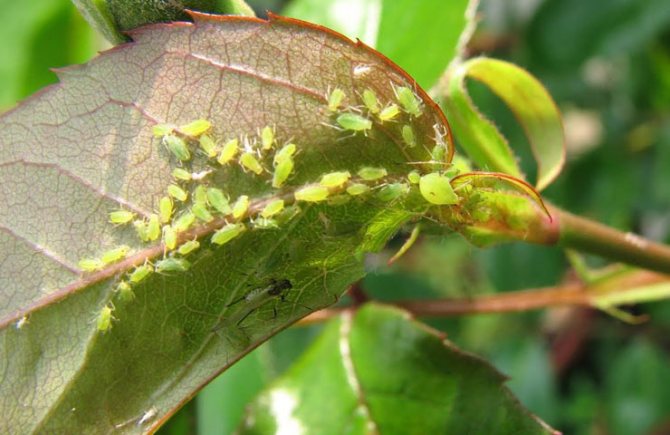

Ladybugs help fight aphids
Aphids are dangerous for crops. By sticking the proboscis into a leaf or stem, it releases a special enzyme and absorbs juices, depleting the plant, stopping its development and growth. And when there are hundreds of these pests, they can easily destroy the entire crop, which is why farmers are so actively planting insects to combat this threat. Moreover, ladybugs eat very little at home and do not require special expenses.
Content rules
Now let's figure out what ladybugs eat at home. It often happens that winter comes unexpectedly earlier than usual. Ladybugs do not have time to prepare for this and go into hibernation. In this case, insects are unable to survive until spring. Only a person can help them. And then the question arises: how to feed the ladybirds?
We offer you to familiarize yourself with Spiders in the house: what they eat, how much they live, how they reproduce
Insects are quite capable of surviving at home, and caring for them does not require much work. That small list of what you need to feed a ladybug can be found in every home.For this, honey diluted in water, water sweetened with sugar, raisins and leaves of vegetable plants are suitable.
Place the ladybirds in a cool place. One of the options is a window sill or a gap between frames. It is necessary to feed the beetles for several days. Then they will hibernate until spring.
Now we know what ladybugs eat at home, and we can always help these cute and useful insects.
A ladybug has started up at home - how to feed her?
If you find a live ladybug in your apartment, help her to live until spring. The best way is to take her out of the house, not throw her into the snow, but find a good shelter. A shed or garage is ideal for this purpose, where they can overwinter without any problems. Do not do this in severe frost, so that the temperature drop for the insect is not too strong.
Keeping an insect in the freezer until spring is not a good idea, the ladybird simply won't survive.
If you want to try to preserve the life of a ladybug at home, you need to know how to feed it and how to properly maintain it. Take any container, arrange a floor of leaves, branches, sticks at its bottom and transfer the ladybug there. We also advise, to create optimal living conditions for the insect, put more straw and dry leaves in the container, loosely mixing with each other, so that artificial cracks are created, which ladybugs love to use as their den. It is possible to use corn tops for shelter in a jar, it will perfectly cover the insect's dwelling from prying eyes. At home, ladybirds are fed with sweet sugar water or honey, you can pour these compounds into a plastic bottle cap. This food is a delicacy for the ladybug. In addition to sweet water, these beetles are fed with raisins and slices of ripe apples. Just like any pet, a ladybug needs a little water.
Think twice before deciding to keep a ladybug at home, because it may not survive until spring and this will not necessarily be your fault, the life of a ladybug is about 2 months.
Where do ladybugs winter?
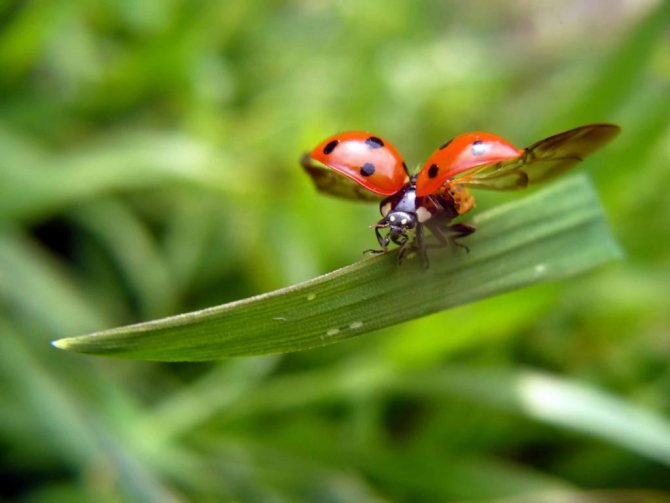

The ladybug can be found on plants that serve as food for aphids. These can be plants such as mustard, buckwheat, coriander, clover, dandelion and others. For wintering, warmer and more secluded corners, cracks and bark of trees are selected, they can huddle in lowlands or at high altitudes, under fallen leaves, in cracks, small cracks in houses, stones, mainly on the sunny side, and so on.
As soon as ladybugs enter the house, they begin to secrete special pheromones that attract other relatives. Pheromones are used as a means of communication during mating and hibernation. Such peculiar "spirits" in insects are very powerful, they can be detected at a distance of up to 500 meters from the place of their application.
The question may arise about what ladybugs eat at home? They are known not to eat cloth, plants, paper, or any other household items. During hibernation, they live off their own accumulated reserves. They also prefer humidity, but the house is usually not very humid in winter, and they use every opportunity to get their own water, as otherwise they can become dehydrated.
Nutrition and maintenance
In order to feed a ladybug, you need to know what it eats. Young individuals are very voracious. Ladybugs eat:
- aphid - is the main source of food;
- leaf beetle;
- worms;
- scale insects;
- ticks.
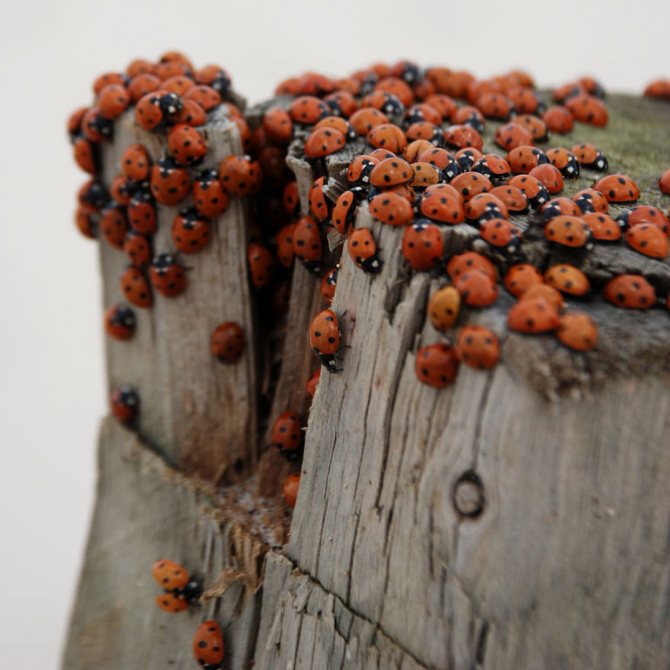

For home improvement, a transparent glass or plastic container with a closed top is ideal. The best option would be a bottle or food box with a lid.But we should not forget that every living organism needs oxygen for life and development, therefore it is necessary to make small holes in the lid for air to enter the container.
The dwelling of the ladybug must be large enough to be able to fly short distances. A twig or any object with an internal hole is perfect as a sleeping place so that the animal can hide there. For variety and beauty, you can add flower petals or grass to the "interior"
It is important not to let the leaves rot and dry in the container, changing them every two days.
Food for keeping a ladybug at home can be:
- honey;
- sugar;
- lettuce;
- raisins;
- apples.
Water plays a special role in the nutritional diet of any organism. For convenience, you can place a metal bottle cap in your home and fill it with water. The water level in the drinker should not exceed the height of the beetle's body so that it does not drown
It is enough to feed and water the insect 2-3 times a day, but it is important not to overfeed it. Eating should be done in small portions.
How to buy
As you know, the main thing that ladybugs eat is aphids. Since this insect and its larvae are very useful for growing crops, many farmers would like to have them in their field. Today it is very easy to do it. You can simply buy them, create the right conditions for them and breed them in your garden or field.
The eggs of these aphid killers can be purchased not only in horticultural centers, but also simply on the Internet. The order will arrive by mail. It remains only to breed the beetles.
One of the conditions is the complete rejection of pesticides. Otherwise, insects will not live in an environment that is not suitable for them. They should be released into the garden during a cool time of the day: in the morning or in the evening. If there is no dew, the plants should be sprayed with water. That's all there is to know about ladybug breeding. These rules are quite simple, and the benefits of these insects are immeasurably high.
How to equip a cow's home
It is not difficult to make housing for an insect: an ordinary closed wooden box will do, the main thing is to equip normal humidity - it is enough to put dried or moistened raisins. In warm weather, you need to maintain the temperature; in hot weather, it is better to move the house to a cool place. You should feed the ladybug at home regularly.
Cute and harmless ladybugs are an ardent enemy of aphids, they save a large amount of the crop. Therefore, agronomists and farmers often keep these insects at home. It is important to properly equip the house for them and organize food.
History of the name
If we consider the Latin name of the insect, in translation it means "scarlet", which corresponds to the color of the bug. And the popular name appeared a long time ago due to sympathy for this insect. In Germany and Switzerland, the creature is called the "bug of the Virgin Mary", in Slovenia and the Czech Republic, the insect is known as the "sun" (as many used to call the ladybug by him in Russia). This creature also lives in Latin American countries, and they call it "St. Anthony's bug" there.
The origin of the domestic name of the ladybug is not known to date. Some researchers believe that the bug got such a name due to its ability to destroy aphids. In this way, a simple creature helps to preserve huge crop plantations. It becomes clear what the ladybugs eat.
The main characteristics of the insect
A ladybug is a small bug, the length of which does not exceed 10 mm (in most cases, it is about 6 mm). The insect has an oval or round body shape. Some species have fine hairs on the upper part of the wings. The body of a ladybug consists of a head, pronotum, chest, three pairs of legs and wings. The insect has a fixed head. The ladybug has relatively large eyes and antennae that are highly flexible.
Thanks to three pairs of legs, the insect can move quickly enough on grass and ground, a little worse - on sliding surfaces. Thanks to the two rear wings, ladybugs perfectly move through the air.
The insect has an excellent defense mechanism against predators (animals, other insects, birds). The bug emits a toxic yellow liquid with an unpleasant odor. The bright colors of the ladybug, which are loved by many, also frighten off enemies.
Features and habitat of the insect
Ladybug (from Latin Coccinellidae) - coleopteran insect of the order of beetles, which lives in almost all corners of the globe, except for Antarctica and permafrost zones. In its natural habitat, this insect does not look defenseless - it is a pronounced predator.
The body of the Coccinellidae has a hemispherical convex shape. The phase of intensive reproduction and development of beetles begins with the onset of spring and lasts until late autumn. The lifespan of a ladybug ranges from 3-4 months to a year, depending on the climatic conditions of the region and the availability of food.
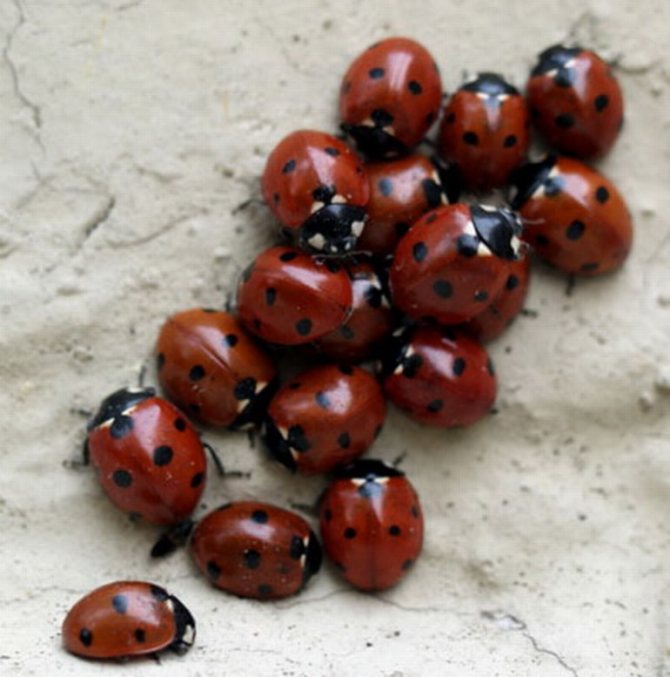

The seven-spotted ladybird (from the Latin Coccinella septempunctata) is the most numerous and widespread species of the order. It is characterized by a pronounced color of the wings (red-orange tones) and black dots on them. It has a peculiar way of protection - in case of danger, it emits a characteristic smelling orange liquid. The developed wings enable the insect to fly.
The main enemies of Coccinellidae are spiders and frogs that feed on them. They are of no interest to birds.
Development stages of a ladybug
By the fifth month of life, most insects of this species reach sexual maturity. Ladybugs reproduce actively already in April. The bugs gain strength after hibernation and only then start mating. The ladybug feeds at this time especially intensively to obtain healthy offspring.
Due to the specific aroma, the male easily finds the female. Eggs are laid near the colonies of aphids, so that in the future a young ladybug can fully eat (what the insect eats was described above). Typically, eggs are attached to the back of the plant's leaves. One female can lay up to 400 eggs, then she dies.
After a few eggs, bright ladybug larvae appear from the laid eggs. What is an insect? From the first days of life, the larva can feed on aphids, plant pieces. Also, the larvae can eat the shell of the egg from which they hatched. Of the many eggs laid, not all develop fully, some of the embryos die. Ripe larvae can also feed on these remains.
From the moment the larva appears and until the maturation of a full-fledged bug, at least a month passes. The larva pupates, a week later a normal ladybug is born. What does a young insect eat? It all depends on the species. If it is a predator, then it will continue to feed on aphids and ticks.
The benefits and harms of ladybugs
These insects are quite voracious. Thanks to this property, it is possible to maintain the full development of vegetable gardens and orchards, to protect them from the invasion of aphids. Just one ladybug larva per day can kill more than 30 aphids. An adult bug can easily deal with hundreds or more pests.
Ladybugs that prefer plant foods are not at all harmless. They live mainly in Latin America, as well as in some regions of South Asia. Such insects cause enormous damage to agricultural land. Such ladybugs are capable of destroying tomatoes, potatoes, cucumbers, and beets.
Where does it live?
Beautiful bugs are common across all continents. They populated all zones. The exceptions are areas where the temperature does not exceed 0 ° C throughout the year and Antarctica.
The insect can be found in all European countries: Great Britain, fragrant in the flowers of Denmark, Sweden, France, Iceland. Germany, Italy, Poland also sheltered this bright insect. Ladybugs fly over India, Korea, Islamic Republic of Japan, South and North America, Mongolia. The distribution area also covers Laos, Myanmar, Indonesia and even Cambodia.
In nature, there are many species of striking representatives of the insect world, their classification is simply huge, and each of them prefer special habitats and each of them has a specific role. Some species settle on those plants that have been damaged by aphids. Others can be seen on field and marsh grasses.

